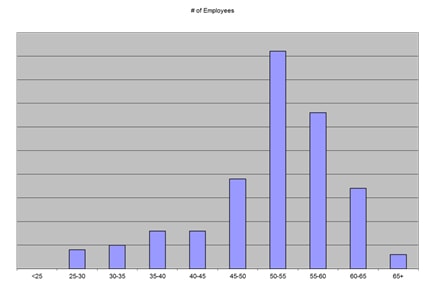The “S” in PESTEL is for Social. In a classic PESTEL analysis of the macro environment (in this case the Nuclear Industry) one looks at changes in social trends that can impact on the demand for products and the availability and willingness of individuals to work. In this first analysis, I’m going to look at the industry demographics affecting development and growth of the industry. Next time, I will be looking at the social factors affecting acceptance of nuclear industry around the world.
Nuclear Industry Demographics
The impending retirement of the baby boom generation has begun to have a significant impact on many industries in the US. This impact is magnified in the nuclear industry by two unique factors.
- Because nuclear was perceived as an undesirable career choice from 1980 to 2005, there is an entire generation largely missing from the ranks of the utilities, vendors, and regulators.
- In the last 5-8 years there has been a significant increase in interest in nuclear energy. Driven by climate change, peak oil and other fossil fuel concerns, this sharp increase has put intense pressure on the industry to hire more workers.
These three factors have combined to create some very unusual demographic curves within the industry. As late as the early 2000’s an analysis of the age demographics in the nuclear workforce showed what is called a J-skewed distribution. The figure demonstrates the age demographics for a typical nuclear company in the time frame. Working age is typically from about 22 until 65, with some folks delaying entry into the work force and some leaving before traditional retirement at 65. You can see in this curve that the peak number of workers was between 50-55 at the time this analysis was performed. The youngest quartile ranged in age up to more than 40 years old.

These graphs were generally moving up one year for each elapsed year as the employee population continued to age. In fact, many company were driven to hire people as qualified as those who left in order to avoid extensive training time. Such practices continued to skew the curve upward.
In “normal” industries one expects a more bell curve shape to the employee population with the peak somewhere near the mid range of employee ages. As nuclear tends to require at least a basic 4 year college degree, the average total career should be something around 40 years, with a median workforce age of 42, a few folks working beyond 65 and a few folks starting out a little less than 22.
With the renewed interest in nuclear power starting in 2003, companies began much more intense hiring campaigns and began to hire younger staff. For many companies this began to lower the age distribution. However, the age demographics are still not normal with a large population under 30 and a large population 50 and over and few people in the middle, highly productive years of their career.
This bi-modal distribution has a profound effect on the transfer of knowledge and leadership as well as the efficient restart of the industry. In some parts of the industry, significant formal training programs have been developed to bring these younger workers up to speed more quickly. In addition, efforts to hire mid-career employees from other industries with required technical skills and train them on the specifics of the nuclear industry has been helping to fill the gap.
Educational Levels
The nuclear industry tends toward a highly educated workforce. A significant fraction of the employees, especially at design firms, have advanced technical degrees. In order to provide such education, universities have to maintain vigorous nuclear engineering departments with access to test reactors and facilities. Many universities operate in partnerships with national labs or other government facilities in order to support such programs.
However, in the operations staff, less formal education and more rigorous technical training is used. Many nuclear plant operators have come out of the navy programs in the US where they are trained to operate the smaller reactors used on navy ships. Training requirements can be fulfilled through formal education or through more industry oriented courses taught by organizations like INPO or companies that specialize in industrial training.
International Views
For the developed countries that already have nuclear power well in hand, the demographics of the US are quite similar. Differences occur in countries with larger population growth and/or having maintained a growing nuclear industry. Japan, for example, has continued to build new plants on an ongoing basis and has encouraged new employment in the field throughout the past 30 years. There is less skewing of age in the workforce and more continuity in training and development.
Countries trying to develop new nuclear programs have found the education levels required to manage a program entirely within country to be quite challenging. The NonProliferation Treaty limits the use of nuclear power for military purposes, further limiting access to some basic research and educational programs. Countries developing nuclear power must look to other non-weapons states to develop models for educating a work force for supporting a nuclear energy policy that is both efficient and safe.

Margaret – like you, I began my nuclear career at the very beginning of the period in which “nuclear was perceived as an undesirable career choice.” We who are still young enough to have a decade or more left before retirement have a lot of work to do. Perhaps the most important challenge is to balance our need to produce something with our need to train our reliefs.
That necessary effort also requires continued promotion of the technology and of the industry as a good place to work. We must raise our voices loud enough to overcome those who believe that there is little to no future in nuclear; otherwise we risk losing some of the young people that we just brought into the industry.
I listen carefully in the kitchen at my office when I get coffee or heat my lunch. I hear what some of the “kids” are saying and know that they are asking questions about whether or not they made the right decision by getting involved in the nuclear industry.
Rod,
I too have heard some of those comments. I’ve spent a great deal of time talking to young people as well. The good news is that almost all of them believe nuclear power is the right choice to answer both ecological and economical issues in this country and around the world. I am hopeful that this generation will make a real difference for our future.